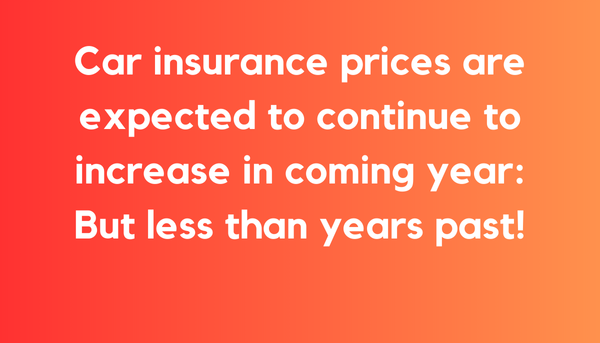
Car insurance prices have been on the rise for the past few years, leaving many drivers frustrated and concerned about their budgets. While rates are expected to continue increasing in the coming year, experts suggest that the hikes may not be as steep as those seen in previous years. This brings a glimmer of hope to motorists who have been grappling with the financial strain of escalating premiums.
Understanding the Factors Behind Rising Car Insurance Costs
Several factors contribute to the continuous rise in car insurance prices. Insurers adjust their rates based on industry-wide trends, economic shifts, and claims data. Understanding these factors can help consumers anticipate changes and make informed decisions when shopping for policies. Below are some of the key drivers behind the ongoing increase in car insurance rates:
1. Increased Cost of Vehicle Repairs
Modern cars are equipped with advanced technology and sophisticated safety features, which, while improving driver safety, also make repairs more expensive. Features such as lane departure warnings, automatic braking systems, and backup cameras require costly parts and specialized labor to repair, pushing up the overall cost of claims.
2. Rising Medical Expenses
Auto accidents often result in medical claims, and as healthcare costs continue to rise, so does the amount insurance companies must pay for injuries. This increase in medical expenses directly impacts insurance premiums, as insurers adjust rates to cover higher claim payouts.
3. Frequency of Severe Weather Events
Climate change has led to an uptick in natural disasters, including hurricanes, floods, and wildfires. These extreme weather events result in an increased number of claims for vehicle damage, forcing insurance companies to raise rates to offset their losses.
4. Increased Incidence of Distracted Driving
The widespread use of smartphones has led to an increase in distracted driving-related accidents. Insurance companies have responded to the higher number of claims by raising premiums across the board.
5. Inflation and Economic Conditions
General inflation affects everything from car repair costs to the price of new vehicles. As the cost of goods and services rises, so too does the cost of insurance. Insurers must adjust their rates to keep up with inflationary pressures.
Why the Rate of Increase May Slow in the Coming Year
While car insurance rates are expected to rise in the next year, analysts predict that the pace of these increases will be less aggressive than in previous years. Here’s why:
1. Stabilization of Supply Chain Issues
One of the key drivers of insurance hikes in recent years has been supply chain disruptions that led to higher costs for vehicle parts and labor. As supply chains stabilize, the cost of repairs may decrease, allowing insurers to slow the rate of premium increases.
2. Adjustments in Underwriting Strategies
Many insurers have already implemented substantial rate increases over the past couple of years. With these adjustments in place, the need for further drastic hikes may be reduced. Insurers are now focusing on refining their underwriting processes to balance risk without overly burdening consumers.
3. Reduced Pandemic-Related Disruptions
The COVID-19 pandemic significantly affected driving patterns, accident rates, and insurance claims. As the world adapts to post-pandemic normalcy, insurers have more predictable data on which to base their pricing strategies, leading to more stable rate adjustments.
4. Competitive Market Pressures
Insurance companies operate in a competitive market, and drastic price increases can drive customers to switch providers. In an effort to retain customers, some insurers may moderate their rate increases to avoid losing business.
How Drivers Can Mitigate Higher Insurance Costs
While car insurance rates may still rise, drivers can take proactive steps to manage their costs and find the best deals available. Below are some strategies to keep premiums affordable:
1. Shop Around for the Best Rates
Insurance companies use different criteria to determine premiums, so shopping around and comparing quotes from multiple providers can help drivers find the best rate available.
2. Bundle Insurance Policies
Many insurance companies offer discounts for bundling auto insurance with other policies, such as homeowners or renters insurance. This can result in significant savings.
3. Maintain a Clean Driving Record
Safe driving habits can lead to lower premiums over time. Avoiding accidents and traffic violations can help qualify drivers for good driver discounts.
4. Increase Deductibles
Opting for a higher deductible can lower monthly premiums. However, drivers should ensure they can afford the out-of-pocket expense in the event of a claim.
5. Take Advantage of Discounts
Many insurers offer discounts for various factors, such as having a good credit score, using telematics devices to monitor driving habits, or being a member of certain professional organizations.
The Future of Car Insurance Pricing
Although rates are expected to continue rising, the predicted slowdown in premium increases provides some relief for drivers. Industry experts remain optimistic that as economic conditions stabilize and insurers adjust their pricing models, the market will become more predictable.
In the long run, advancements in vehicle technology, improvements in road safety, and regulatory changes could influence insurance pricing trends. Consumers should stay informed about industry developments and reassess their policies regularly to ensure they are getting the best coverage at the most reasonable cost.
Final Thoughts
Car insurance prices have been a growing concern for many drivers, but the projected slowdown in premium increases offers a slight reprieve. While rates are unlikely to decrease, the less aggressive hikes mean that consumers may have an easier time managing their budgets. By staying proactive, shopping for better deals, and utilizing available discounts, drivers can navigate rising insurance costs more effectively.
As the auto insurance landscape continues to evolve, staying informed and making strategic decisions will be key to securing affordable and adequate coverage in the coming years.